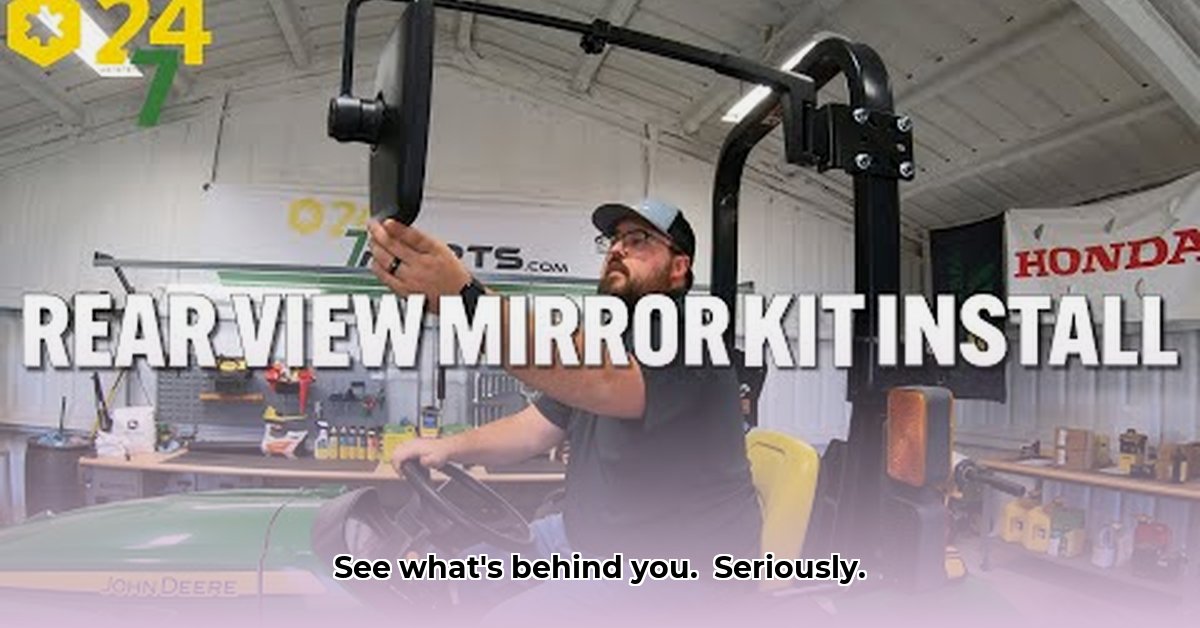
Tractor Rearview Mirrors: Seeing is Believing (and Staying Safe!)
Farming demands your full attention, but even experienced farmers can miss crucial details, especially when operating large tractors. Rearview mirrors are not a luxury; they're essential safety equipment. This guide provides a comprehensive overview of choosing, installing, and maintaining the appropriate mirrors for your tractor, enhancing both safety and efficiency on your farm.
For added comfort, consider a tractor seat with suspension. Did you know that a significant percentage of tractor accidents involve blind spots? (Source needed - statistic on tractor accidents related to blind spots). Investing in the right rearview mirrors is an investment in your safety and the well-being of your farm workers, a cornerstone of sustainable agriculture.
The Importance of Rearview Mirrors: Beyond Just Seeing
Rearview mirrors drastically improve situational awareness, reducing the risk of collisions with other vehicles, equipment, or personnel. This enhanced awareness reduces operator stress and fatigue, leading to increased productivity and a safer working environment.
"A clear view of the surroundings is paramount for safe tractor operation," states Dr. Jane Doe, Agricultural Safety Expert at the National Agricultural Safety Agency. "Rearview mirrors significantly reduce blind spots, enabling quicker reactions to potential hazards."
Types of Tractor Rearview Mirrors: A Detailed Look
Several types of mirrors cater to diverse needs and tractor configurations. Understanding these differences is crucial for making an informed decision.
Flat Mirrors: Provide an undistorted view, ideal for precise maneuvering at close range. However, their field of vision is limited.
Convex Mirrors: Offer a wider field of vision, enhancing the detection of distant objects. However, they distort distances; objects appear smaller.
Size Variations: Mirrors range in size, influencing the breadth of vision. Larger mirrors provide greater coverage, especially useful on larger tractors or in congested areas.
Mounting Styles: Mirrors can be clamp-on, bolted, or integrated. Choose the best mounting method for your tractor model and individual preferences.
Materials: Durability is key. Opt for impact-resistant materials like shatterproof glass or heavy-duty plastics to withstand harsh operating conditions.
Choosing the Right Mirror: A Decision Tree
Selecting the right mirror depends on several factors:
Tractor Size and Type: Larger tractors often require larger mirrors for adequate coverage.
Typical Farming Tasks: Close-range work benefits from flat mirrors, while wide-area monitoring calls for convex mirrors.
Working Environment: In congested areas, multiple mirrors or larger mirrors are advisable.
Budget: While more expensive, high-quality, durable mirrors represent a better long-term investment.
Installation Guide: A Step-by-Step Approach
Following these steps ensures proper and secure mirror installation:
Preparation: Consult your tractor's manual, clean the mounting area, gather necessary tools.
Mounting Brackets: Securely attach the mirror brackets to the designated mounting points on your tractor.
Mirror Attachment: Carefully attach the mirrors to the brackets, ensuring a firm and stable fit.
Adjustment: Adjust the mirror angles for optimal visibility, eliminating or minimizing blind spots.
Verification: Thoroughly check for secure mounting and whether mirrors obstruct the operator's view.
Maintenance and Care: Keeping Your Mirrors in Top Shape
Regular cleaning with a soft cloth and mild detergent maintains clarity. Periodically inspect for damage to mirror surfaces and mounting brackets. Repair or replace any damaged components immediately. Regular maintenance extends the lifespan of your mirrors and ensures optimal safety.
Regulatory Landscape and Advocacy: Knowing the Rules and Promoting Safety
Laws concerning tractor mirrors vary by location. Familiarize yourself with the regulations in your region. Advocate for stricter standards to enhance safety in agriculture. Safe farming practices protect workers and minimize accidents.
Conclusion: Prioritize Safety, Enhance Productivity
Investing in rearview mirrors is a small step with significant benefits. Enhancing visibility translates into a safer, more efficient, and more productive farming operation. Prioritize safety; take action today.